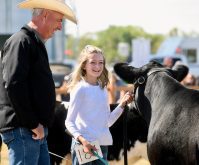The feedlot sector in the West is growing again, according to the Canfax annual demographic survey of finishing feedlots in Alberta and Saskatchewan with a minimum one-time bunk capacity of 1,000 head.
As of January 1, 2017, there were 158 feedlots of that size on the Canfax list, which translates to eight more finishing lots than last year. As a consequence, the total bunk capacity in the two provinces has grown by 1,550 spots to a total of 1,421,950 head.
The number of feedlot owners in the survey climbed to 133 from 127 in 2016.
Read Also

The Canadian Cattle Association’s international advocacy efforts
Global ag policies affect Canadian food policy, so the Canadian Cattle Association participates in international and domestic forums
This is the second consecutive year that a small increase has been recorded in the annual survey, although the total capacity is still 19 per cent below the peak year of 2008.
Alberta’s finishing capacity dropped by 10,950 head leaving bunk space for the province at 1,327,950 head. This is still 93.3 per cent of the western total but is also the lowest capacity for the province since this survey was first taken in 2000.
The survey results came as a bit of a surprise following the decision by the owners of Western Feedlots Ltd. to stop buying cattle last year. Canfax senior analyst Brian Perillat says the Strathmore lot was closed before January 1, 2016, so the year-over-year loss from Western was only the one lot. A third lot still had cattle on feed at the start of this year.
“Over the past year there has been a small resurgence of small to mid-size feedlots under 10,000 head that had previously switched to background in 2013-15 but are now finishing a larger portion of their cattle,” wrote Perillat in reporting the results of the annual survey.
For the third year in a row Saskatchewan also recorded an increase in finishing capacity with its onetime capacity going up by 15 per cent for a total capacity of 94,000 head.
The survey also covers some operational aspects as well, and Perillat says turn rates have generally been declining since 2014 for feedlots of all sizes.
“This could be partly related to feeding cattle longer and growing them larger, as well as possibly more calves going directly to feedlots as Canadian cattle numbers have declined, and fall yearling supplies have tightened,” he says.
For industry analyst Kevin Grier the more interesting question is what will happen to the feedlot sector this year.
In the April 3 edition of his Canadian Cattle Market Report, Grier notes the winding down of Western’s High River in a few months will remove 32,000 head from Alberta’s total capacity. Will enough smaller- to medium-sized backgrounding lots convert or expand their finishing capacity during the year to make up for this loss?
The answer will probably lie with the profitability of feedlots in 2017. After losing more than an average of $200 per head last year, he says 2017 brought a welcome change to western feedlot operators based on Canfax data which reported annual profits of $200 per head in January and February, and well over $300 in March.
“Looking at projected profits, however, the message turns negative again,” says Grier pointing to Canfax Trends models that show red ink on yearling steers in June and big losses on the few calves placed in the first part of this year.
“The overall message is that the feedlot financial picture over the last couple of years, as well as this year, does not inspire confidence in expansion,” he says.
















